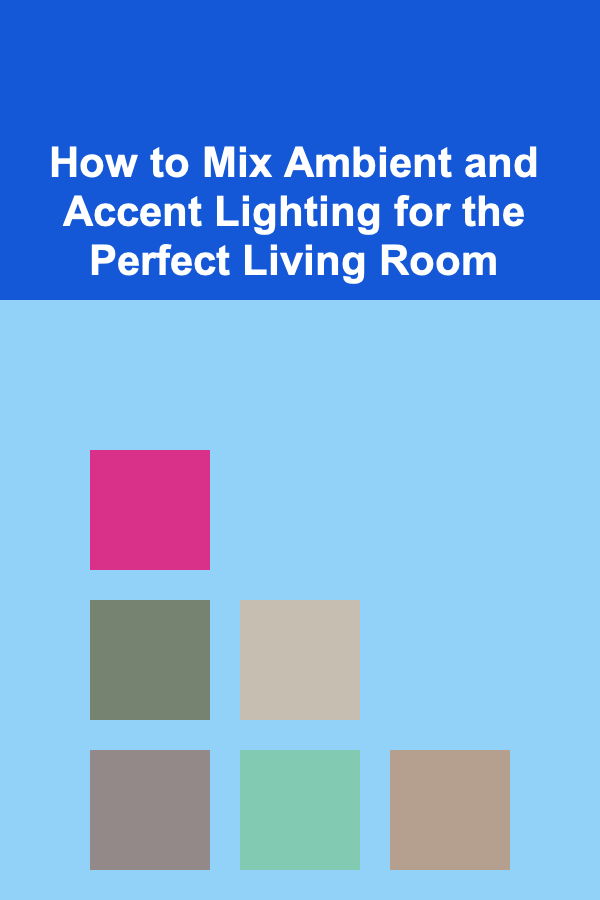
How to Mix Ambient and Accent Lighting for the Perfect Living Room
ebook include PDF & Audio bundle (Micro Guide)
$12.99$10.99
Limited Time Offer! Order within the next:

Lighting is an essential component of interior design that can transform the mood, aesthetics, and functionality of any room. In the living room, lighting plays a crucial role in creating a welcoming and comfortable space where people gather, relax, and entertain. The right mix of ambient and accent lighting can elevate the room's ambiance, highlight architectural features, and set the tone for various activities, whether it's reading, watching television, or hosting guests.
In this article, we'll dive deep into how to mix ambient and accent lighting effectively to achieve the perfect living room atmosphere. From understanding the differences between the two types of lighting to exploring practical tips on choosing the right fixtures, we'll guide you through the process of creating a well-lit, inviting space.
Understanding Ambient Lighting
Ambient lighting is the primary, overall lighting in a room, designed to provide even illumination across the entire space. Its purpose is to ensure that the room is sufficiently lit for general activities without creating harsh shadows or excessive glare. Ambient lighting sets the foundation for other lighting layers in the room, ensuring that the space is both functional and comfortable.
Ambient lighting comes in many forms, including overhead ceiling lights, chandeliers, recessed lights, and wall-mounted fixtures. It is usually a soft, diffused light that creates a balanced environment, eliminating the need for supplementary light sources during normal daytime activities.
The goal of ambient lighting is to provide a consistent, comfortable light level across the entire room, ensuring you can move around and perform basic activities such as cleaning, cooking, or socializing. It should not overpower the room but should complement the space's size and layout.
Characteristics of Ambient Lighting:
- Soft and diffused: Ambient lighting should fill the room with light without creating harsh contrasts or shadows.
- Balanced and uniform: It provides even light across the entire space, preventing dark corners or areas of excessive brightness.
- Comfortable: Ambient light is typically soft to avoid eye strain and contribute to a relaxing atmosphere.
Understanding Accent Lighting
While ambient lighting provides overall illumination, accent lighting is used to highlight specific features in a room. It's designed to draw attention to particular areas, architectural elements, or objects that you want to emphasize, such as artwork, sculptures, plants, or unique furniture pieces. Accent lighting adds depth, interest, and drama to a space, creating visual contrast with the ambient light.
Accent lighting is typically brighter and more focused than ambient lighting, and it works by creating pools of light that highlight specific areas or objects. It can come in the form of track lighting, wall sconces, spotlights, or picture lights, and it should be used strategically to create a sense of depth and visual intrigue.
The key to effective accent lighting is balance. Too much accent lighting can make a room feel harsh and uninviting, while too little can leave the room feeling flat and lifeless. When used in combination with ambient lighting, accent lighting can create layers of light that add warmth, texture, and sophistication to the living room.
Characteristics of Accent Lighting:
- Focused and directional: Accent lighting is used to draw attention to specific objects, features, or areas.
- Brighter than ambient light: Accent lights are usually more intense and narrow in focus to highlight the selected object or area.
- Creates visual interest: Accent lighting helps create depth and contrast, making the space more dynamic.
How to Mix Ambient and Accent Lighting
Combining ambient and accent lighting is key to creating a harmonious, well-lit living room. The goal is to use the two types of lighting in tandem to provide both general illumination and highlight key design elements. Here's how to achieve the perfect balance between ambient and accent lighting:
1. Start with Ambient Lighting
The first step in creating a well-lit living room is to establish your ambient lighting. This will serve as the foundation for your room's lighting scheme. The idea is to choose lighting fixtures that provide consistent, even light throughout the room, setting the stage for accent lighting to shine.
Some options for ambient lighting include:
- Recessed lighting: Ceiling-mounted recessed lights can be strategically placed throughout the room to create a soft, uniform light that covers the entire space. These lights are great for rooms with lower ceilings where traditional fixtures may not be suitable.
- Chandeliers: A statement chandelier can provide a significant amount of ambient light while adding a focal point to the living room. Chandeliers come in a variety of styles, from modern to traditional, and can be a great addition to rooms with higher ceilings.
- Ceiling-mounted fixtures: Overhead flush-mount or semi-flush-mount ceiling lights are common ambient lighting choices. They can provide ample light without taking up too much space, making them ideal for small or mid-sized living rooms.
- Floor and table lamps: In some cases, lamps can be used to provide ambient lighting, especially if your living room lacks overhead lighting. Tall floor lamps can shine light upward to create soft, diffused light, while table lamps can be placed around the room for localized ambient lighting.
The key is to make sure the ambient lighting is balanced and consistent, so no area of the room feels too dark or overly bright.
2. Add Accent Lighting to Create Depth and Focus
Once the ambient lighting is in place, the next step is to add accent lighting to highlight key features and add depth to the space. Accent lighting can be used to emphasize artwork, architectural details, or any objects that you want to bring attention to.
Here are some ways to incorporate accent lighting into your living room:
- Wall-mounted fixtures: Wall sconces or picture lights can be used to highlight artwork, framed photographs, or decorative objects on the walls. A picture light, for example, can provide a concentrated beam of light on the artwork, making it stand out against the surrounding walls.
- Track lighting: Track lights are highly adjustable and allow you to direct light exactly where you need it. They can be installed on the ceiling or along the walls to spotlight specific areas of the room. Track lighting is particularly effective for highlighting gallery walls, sculptures, or unique furniture pieces.
- Spotlights: If you have specific features, such as a fireplace or a statement piece of furniture, consider using adjustable spotlights to focus light on those areas. Spotlights can provide more intense lighting, adding drama and emphasizing the feature.
- Table and floor lamps with directional heads: Table and floor lamps equipped with adjustable heads can act as accent lighting when positioned strategically around the room. These lamps can be aimed at architectural elements or decorative objects to create visual interest.
The purpose of accent lighting is to draw the viewer's eye to particular features or details, making the space feel more dynamic and layered.
3. Use Dimmers for Flexibility
One of the most effective ways to mix ambient and accent lighting is to incorporate dimmers into your lighting design. Dimmers allow you to adjust the brightness of your lights, giving you the flexibility to change the mood and atmosphere of the room depending on the time of day or the activity.
- Dimming the ambient light: At certain times, you may want to create a softer, more intimate atmosphere by dimming the ambient lighting. This can be particularly useful in the evening when you're relaxing or watching television.
- Adjusting accent lights: You can also use dimmers for accent lighting, allowing you to highlight specific objects or areas with more intensity or reduce the brightness for a subtler effect. For example, you may want to brighten the spotlights on artwork when entertaining guests and dim them when you're enjoying a quiet evening.
Dimmers add versatility to your living room lighting, making it easy to transition between different lighting moods throughout the day.
4. Layer Your Lighting for Balance
The most effective lighting design incorporates multiple layers of light, combining ambient, accent, and task lighting for a well-rounded atmosphere. In the living room, this means using both overhead ambient lighting and focused accent lighting, along with task lighting (like reading lamps) to meet all your lighting needs.
- Combine different types of accent lighting: To create a dynamic and well-balanced living room, you can layer different types of accent lighting. For example, you can use wall sconces to highlight architectural elements and track lighting to illuminate artwork. Layering different sources of accent lighting creates visual depth and makes the space feel more dynamic.
- Consider the natural light: Don't forget to account for natural light in your design. Large windows or glass doors can provide ample natural light during the day, and you should design your lighting around these sources. In the evening, ambient and accent lighting should complement the lack of daylight, ensuring the room is still well-lit.
By thoughtfully layering your lighting, you can create a living room that feels inviting, balanced, and functional.
5. Choose the Right Light Bulbs
The type of light bulbs you choose plays a significant role in the overall effect of your lighting. When mixing ambient and accent lighting, consider the following factors:
- Color temperature: The color temperature of your bulbs affects the tone of the light in the room. Warm white light (2700K to 3000K) creates a cozy and inviting atmosphere, while cool white (4000K to 5000K) provides a more neutral and vibrant light. For living rooms, warm light is typically preferred, but it can be a matter of personal preference.
- Lumens: Lumens measure the brightness of a light bulb. For ambient lighting, you'll want a higher lumen output to ensure the entire room is well-lit. Accent lighting, on the other hand, should be more focused and may require brighter bulbs in specific spots to highlight objects effectively.
Conclusion
Mixing ambient and accent lighting in your living room is an art that requires careful consideration of your space's design, the purpose of each light source, and how the different layers of light work together. By understanding the role of ambient lighting in providing general illumination and accent lighting in adding depth and focus, you can create a living room that is both functional and aesthetically pleasing.
Through strategic use of different lighting types, the right fixtures, and a thoughtful approach to layering and dimming, you can transform your living room into a space that feels warm, inviting, and visually engaging. Whether you're hosting a party, reading a book, or simply relaxing, the perfect combination of ambient and accent lighting can set the stage for any occasion.
Reading More From Our Other Websites
- [Personal Financial Planning 101] How to Set Financial Goals and Achieve Them Consistently
- [Organization Tip 101] How to Choose the Right Office Supplies for Maximum Efficiency
- [Home Space Saving 101] How to Create a Minimalist Living Room That Saves Space
- [Home Security 101] How to Install and Maintain a Home Security Alarm System
- [Home Rental Property 101] How to Get the Most Out of Your Rental Property Tax Deductions
- [Personal Care Tips 101] How to Use Hair Mousse to Achieve Salon-Quality Volume and Body
- [Personal Finance Management 101] How to Automate Your Savings for a Stress-Free Future
- [Biking 101] The Ultimate Guide to Bike Accessories: Enhance Your Ride with the Right Gear
- [Home Lighting 101] How to Use Smart Lighting to Improve Your Home's Efficiency
- [Personal Care Tips 101] How to Choose a Brow Gel for Thin or Sparse Eyebrows

How to Choose the Right Investment Strategy for Your Lifestyle
Read More
How to Foster Respect and Cooperation in Shared Spaces
Read More
How to Make Money Online as a Programmer? 10 Actionable Ideas
Read More
How to Soundproof Your Walls During Renovation Projects
Read More
How to Practice Forgiveness for Yourself and Others
Read More
How to Implement a Successful Compliance Training Program
Read MoreOther Products

How to Choose the Right Investment Strategy for Your Lifestyle
Read More
How to Foster Respect and Cooperation in Shared Spaces
Read More
How to Make Money Online as a Programmer? 10 Actionable Ideas
Read More
How to Soundproof Your Walls During Renovation Projects
Read More
How to Practice Forgiveness for Yourself and Others
Read More